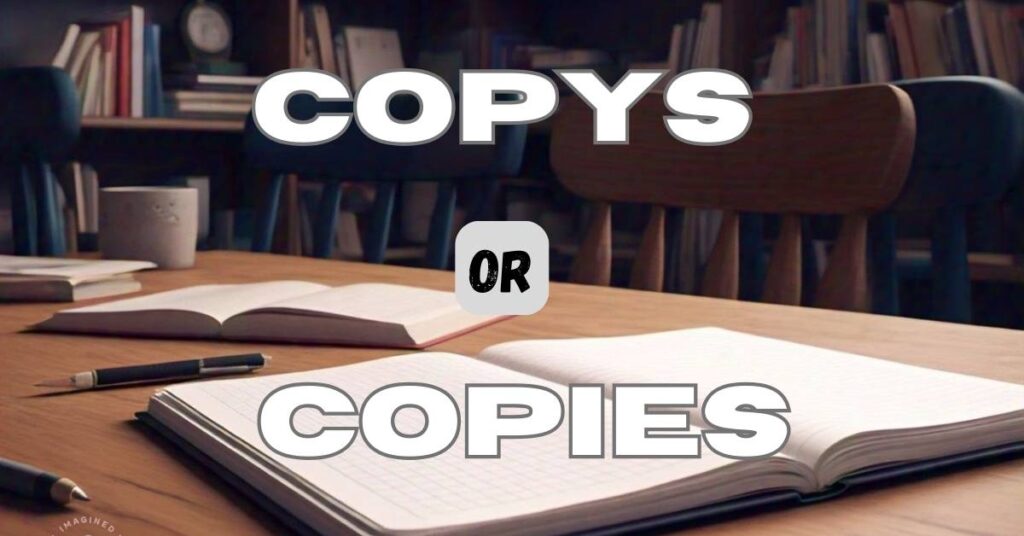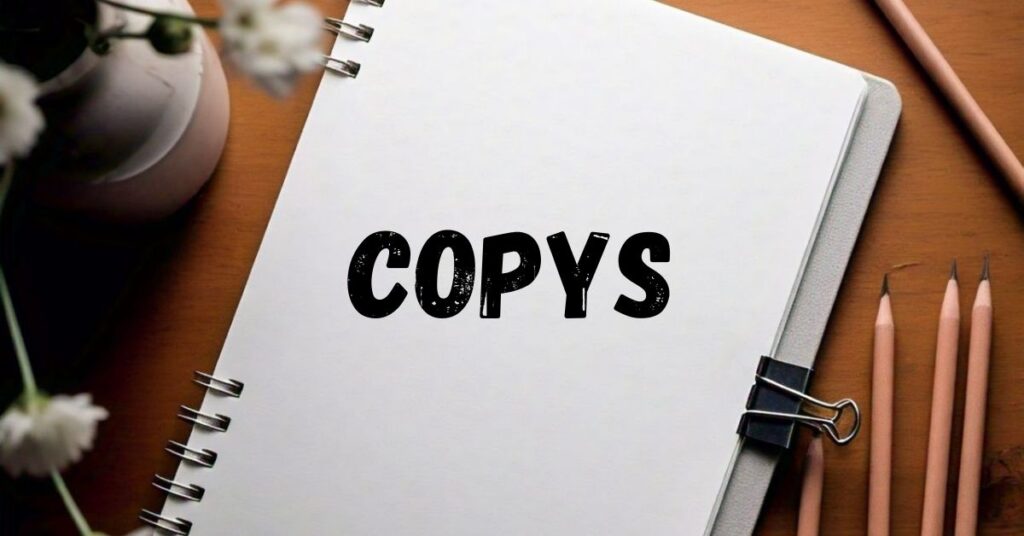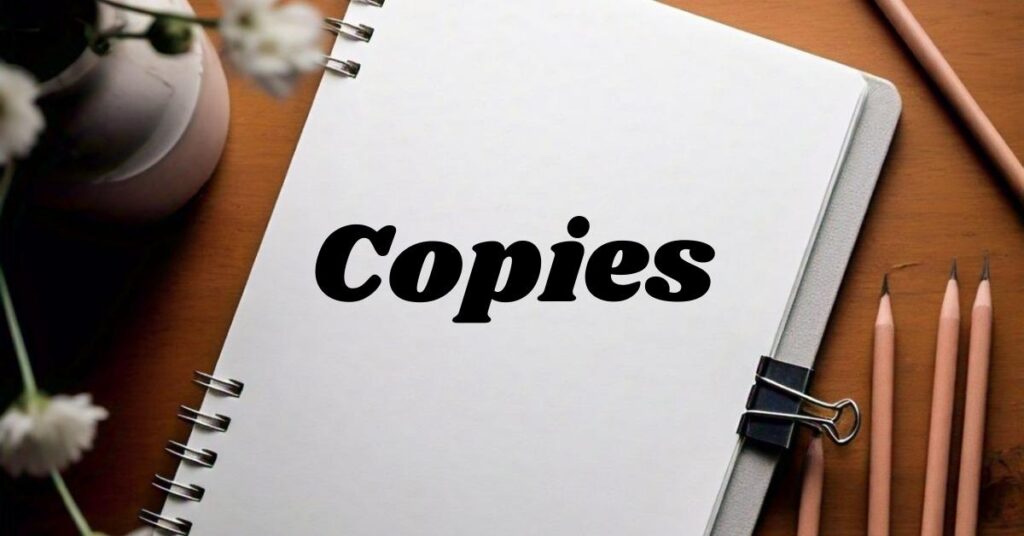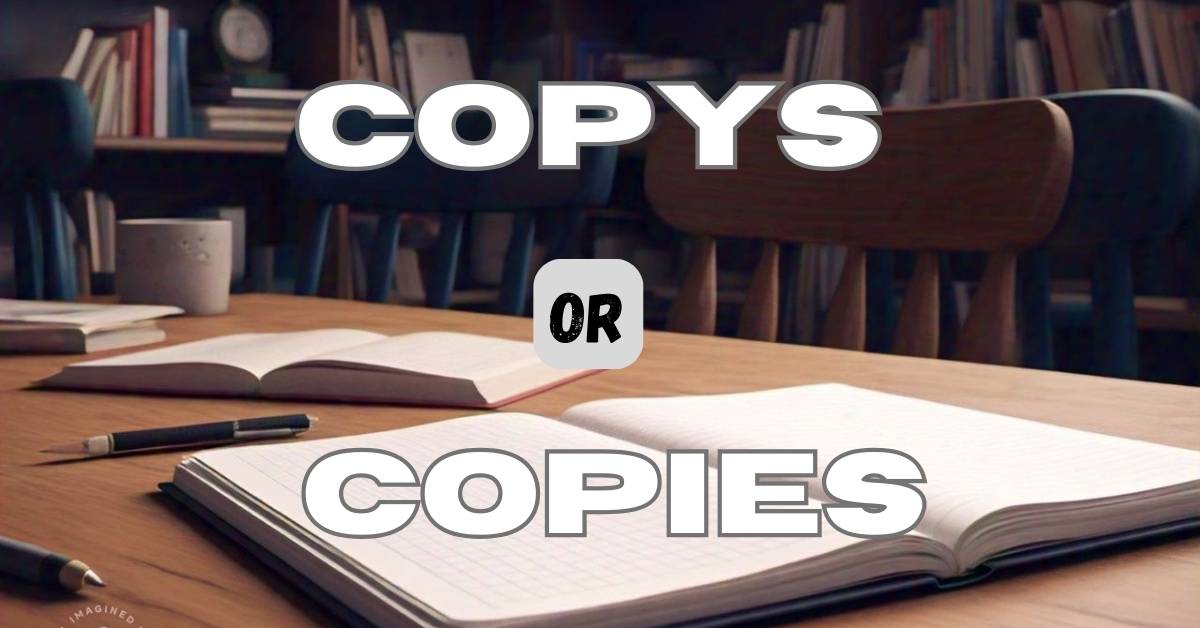Copys or Copies can often confuse writers and speakers alike. Many people mistakenly use “copys” when they mean “copies,” leading to common errors that can undermine effective communication.
Understanding the correct terminology is crucial for maintaining language accuracy and clarity in writing. This article will explore the distinctions between these terms, providing definitions, usage examples, and tips to avoid writing mistakes.
By clarifying the correct forms and their meanings, you’ll enhance your professional communication skills and ensure your writing adheres to established grammar rules. Let’s dive into the nuances of copy terminology and uncover the right way to express your ideas without confusion.
Understanding Copys or Copies

The word “copy” refers to a duplicate of something, whether it’s a document, a piece of art, or any other item. The term can be used as both a noun and a verb. When we talk about the plural form of copy, it becomes copies.
However, some people mistakenly write “copys,” which is incorrect. Understanding this distinction is crucial for effective communication.The importance of using the correct terminology cannot be overstated.
Misunderstanding terms like “copys” and “copies” can lead to confusion and miscommunication. In professional settings, using the right words enhances your credibility and ensures that your message is clear.
Origins of the Copys
The term “copy” has its origins in the Latin word “copia,” which means abundance or plenty. Over time, it evolved into the English word we use today, reflecting the idea of duplication or reproduction.
As language continues to evolve, so do its rules and forms. While new variations may emerge, it is crucial to adhere to established norms for clarity and professionalism in communication. Understanding this origin helps appreciate the significance of accurate terminology in writing.
Copys: Definition and Usage

The term “copys” is often seen as a typo or an incorrect spelling of copies. In most contexts, you won’t find any legitimate use for “copys.” It’s essential to recognize that this form does not exist in standard English usage. If you encounter it, it’s likely due to a typing mistake or a misunderstanding of grammar rules.
When using the word as a noun, remember that the correct form is always copies. For example, saying “I need three copies of this document” is correct, while “I need three copys” is not.
The Plural of Copy
The plural of copy is straightforward: it’s copies. Many people struggle with pluralization in English due to its irregularities.
However, knowing that adding an “ies” at the end of words ending in “y” (after a consonant) will typically give you the plural form can help avoid common errors.
“Copys” as a Noun
As mentioned earlier, using “copys” as a noun is incorrect. If you see someone using this term in writing or speech, they likely made a mistake. Instead, always opt for copies when referring to more than one instance of something being duplicated.
“Copys” as a Verb
Similarly, using “copys” as a verb is also incorrect. The proper verb form would be to say “to copy.” For example, you might say, “I will copy this document for you.” Again, it’s important to avoid using “copys” in any context to maintain professionalism and clarity.
Copies: Definition and Usage

The term copies refers to multiple instances of something that has been reproduced or duplicated from an original source. It can apply to documents, images, or any material that can be replicated.
For example, if you create several printed versions of a report for distribution at a meeting, you would say you made copies of that report.
Copies Meanings
The meanings associated with copies can vary depending on context but generally refer to duplicates or reproductions of original materials. Understanding these nuances helps ensure accurate language usage in your writing.
10 Synonyms
Here are ten synonyms for copies, which can be useful when discussing document duplication:
- Duplicates
- Reproductions
- Replicas
- Clones
- Prints
- Versions
- Facsimiles
- Transcripts
- Impressions
- Reductions
Using these synonyms can enhance your writing style while avoiding repetition.
Side by Side Comparison
| Term | Definition | Usage Example |
| Copys | Incorrect form; often a typo | N/A |
| Copies | Correct plural form of copy | I made three copies of the document. |
This table highlights the differences between the two terms clearly.
Everyday Usage Examples

In everyday language, it’s essential to use words correctly to avoid confusion:
Using “copys”:
“I need three copys for my project.” (Incorrect)
Using “copies”:
“I need three copies for my project.” (Correct)
These examples illustrate how easily one can slip into using incorrect terminology without realizing it.
Copys Example
Using “copys” in a sentence is a common mistake. For instance, saying, “I made two copys of my presentation” is incorrect. The proper form is “copies.”
This simple error can lead to confusion in communication. Always remember to use “copies” when referring to multiple duplicates to ensure clarity and maintain professionalism in your writing.
Copies Example
A great way to use “copies” correctly is in the sentence, “Please send me five copies of the report.” Here, “copies” clearly indicates the request for multiple duplicates of a document.
Using “copies” in this context not only conveys the message accurately but also maintains professionalism.
Properly using terms like “copies” enhances clarity and ensures effective communication, making it easier for others to understand your needs context.
Read More Article: Targetted vs Targeted: What’s the Difference?
Examples of Sentences with “Copies” and “Copy” (Noun)
- I need two copies of this report.
- She printed five copies for the meeting.
- Can you make a copy of this document?
- The teacher distributed copies to all students.
- I found an old copy of that book.
- He requested additional copies for his colleagues.
- Please send me a digital copy via email.
- The library has several copies available for checkout.
- I lost my copy, so I need another one.
- They made multiple copies for distribution.
Examples of Sentences with “Copies” and “Copy” (Verb)
- She copies the files to her USB drive.
- Can you copy this document before sending it?
- He always copies his notes during class.
- Please copy the report onto my desk.
- They copy important data onto backup drives.
- I’ll copy you on that email for reference.
- She quickly copies the information from her notebook.
- He often copies designs from popular magazines.
- Make sure to copy all relevant sections accurately.
- The assistant copies documents for the manager daily.
Common Mistakes of Copys or Copies

Many people make common errors when using these terms due to their similar sounds but different meanings and spellings.
This includes using copys instead of copies, which can lead to misunderstandings in communication.
Tips to Avoid Spelling Mistakes
To avoid these mistakes in your writing:
- Always proofread your work before finalizing it.
- Use spell-check tools available in most word processors.
- Familiarize yourself with common misspellings related to your field or interests.
- Practice writing regularly to improve your skills and reduce errors over time.
Read More Article: Witness’ or Witness’s: Which One is Correct?
FAQS: Copys or Copies
Is it copys or copies?
The correct term is “copies,” as “copys” is a misspelling.
What is the plural version of copy?
The plural version of “copy” is “copies,” formed by changing “y” to “ies.”
Is soft copy singular or plural?
“Soft copy” is singular, referring to one digital version of a document.
What is a word for copies?
Synonyms for “copies” include duplicates, reproductions, and facsimiles
Conclusion
Understanding the difference between Copys or Copies is essential for clear and effective communication. Always remember that “copies” is the correct term when referring to multiple duplicates of a document or item.
Misusing “copys” can lead to confusion and undermine your professionalism in writing. By adhering to proper grammar rules and being mindful of common mistakes, you can enhance your language skills and ensure your messages are conveyed accurately. Embrace the clarity that comes with using the right terminology.

